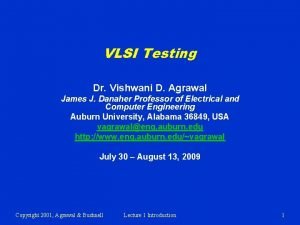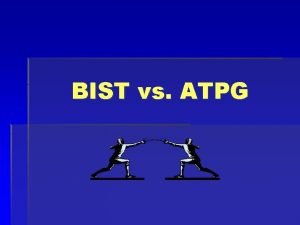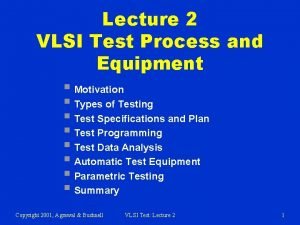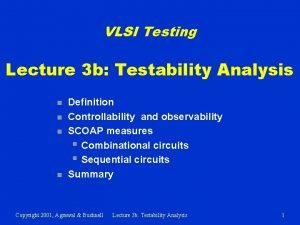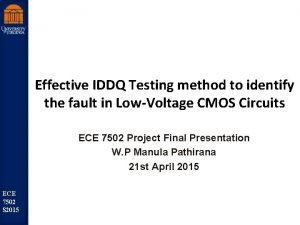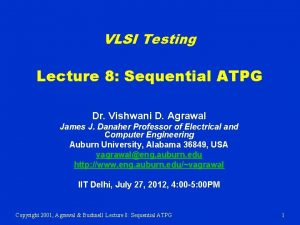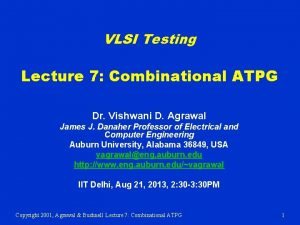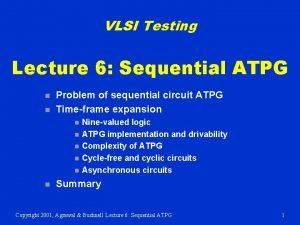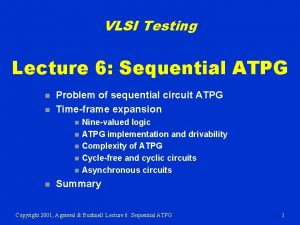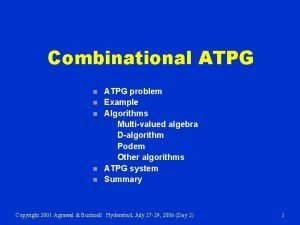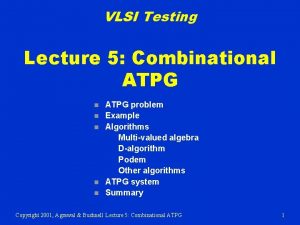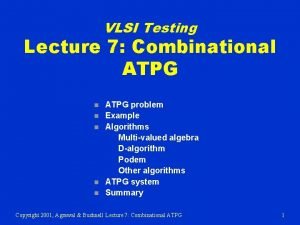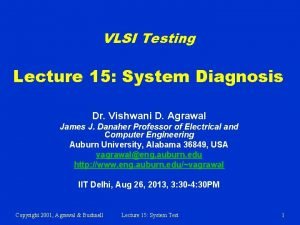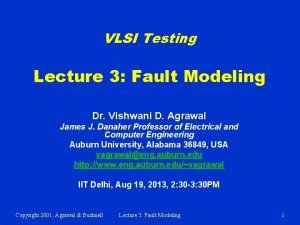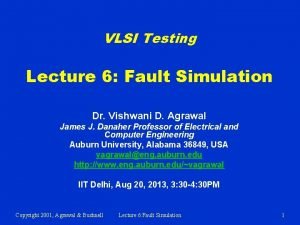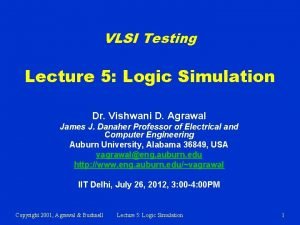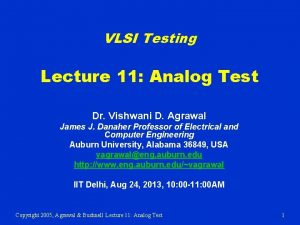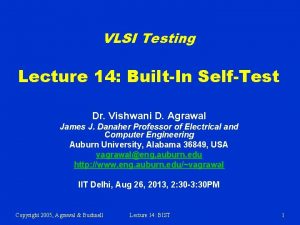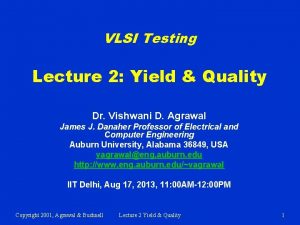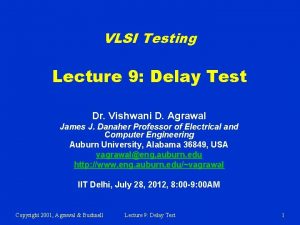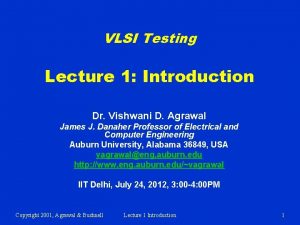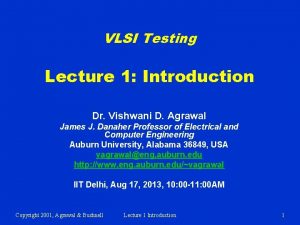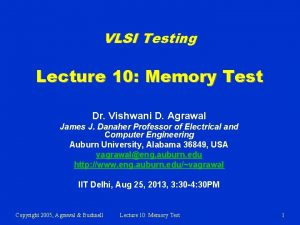VLSI Testing Lecture 8 Sequential ATPG Dr Vishwani





















- Slides: 21

VLSI Testing Lecture 8: Sequential ATPG Dr. Vishwani D. Agrawal James J. Danaher Professor of Electrical and Computer Engineering Auburn University, Alabama 36849, USA vagrawal@eng. auburn. edu http: //www. eng. auburn. edu/~vagrawal IIT Delhi, Aug 21, 2013, 3: 30 -4: 30 PM Copyright 2001, Agrawal & Bushnell Lecture 8: Sequential ATPG 1

Contents n n Problem of sequential circuit ATPG Time-frame expansion n n n Nine-valued logic ATPG implementation and drivability Complexity of ATPG Cycle-free and cyclic circuits Asynchronous circuits Summary Copyright 2001, Agrawal & Bushnell Lecture 8: Sequential ATPG 2

Sequential Circuits n n A sequential circuit has memory in addition to combinational logic. Test for a fault in a sequential circuit is a sequence of vectors, which n n Initializes the circuit to a known state Activates the fault, and Propagates the fault effect to a primary output Methods of sequential circuit ATPG n n Time-frame expansion methods Simulation-based methods Copyright 2001, Agrawal & Bushnell Lecture 8: Sequential ATPG 3

Example: A Serial Adder An Bn 1 1 s-a-0 D 1 1 D Cn X Cn+1 X Combinational logic FF Copyright 2001, Agrawal & Bushnell Lecture 8: Sequential ATPG Sn X 1 4

Time-Frame Expansion An-1 Bn-1 1 1 An Bn Time-frame -1 s-a-0 D 1 X 1 1 Cn-1 1 D Time-frame 0 s-a-0 D D 1 X Cn X 1 D 1 Cn+1 1 Combinational logic Sn-1 1 Sn X D FF Copyright 2001, Agrawal & Bushnell Lecture 8: Sequential ATPG 5

Concept of Time-Frames n If the test sequence for a single stuck-at fault contains n vectors, n n n Fault Unknown or given Init. state Comb. block Replicate combinational logic block n times Place fault in each block Generate a test for the multiple stuck-at fault using combinational ATPG with 9 -valued logic Vector -n+1 Timeframe -n+1 PO -n+1 State variables Vector -1 Vector 0 Timeframe -1 Timeframe 0 PO -1 PO 0 Copyright 2001, Agrawal & Bushnell Lecture 8: Sequential ATPG Next state 6

Example for Logic Systems FF 1 A s-a-1 B FF 2 Copyright 2001, Agrawal & Bushnell Lecture 8: Sequential ATPG 7

Five-Valued Logic (Roth) 0, 1, D, D, X A 0 s-a-1 FF 2 A 0 s-a-1 D D X X D D Time-frame -1 B X Copyright 2001, Agrawal & Bushnell Lecture 8: Sequential ATPG Time-frame 0 FF 1 FF 2 B X 8

Nine-Valued Logic (Muth) 0, 1, 1/0, 0/1, 1/X, 0/X, X/0, X/1, X A 0 A X s-a-1 0/1 FF 2 X/1 X 0/X X 0/1 X/1 Time-frame -1 B X Copyright 2001, Agrawal & Bushnell Lecture 8: Sequential ATPG Time-frame 0 B FF 1 FF 2 0/1 9

Implementation of ATPG n n n Select a PO for fault detection based on drivability analysis. Place a logic value, 1/0 or 0/1, depending on fault type and number of inversions. Justify the output value from PIs, considering all necessary paths and adding backward time-frames. If justification is impossible, then use drivability to select another PO and repeat justification. If the procedure fails for all reachable POs, then the fault is untestable. If 1/0 or 0/1 cannot be justified at any PO, but 1/X or 0/X can be justified, the fault is potentially detectable. Copyright 2001, Agrawal & Bushnell Lecture 8: Sequential ATPG 10

Drivability Example (10, 15) s-a-1 8 d(0/1) = d(1/0) = 20 8 d(0/1) = 4 d(1/0) = (10, 16) d(0/1) = 9 d(1/0) = FF (6, 10) d(0/1) = 109 d(1/0) = d(0/1) = d(1/0) = 32 (17, 11) d(0/1) = 120 d(1/0) = 27 8 (CC 0, CC 1) = (6, 4) (5, 9) 8 (4, 4) (22, 17) 8 (11, 16) CC 0 and CC 1 are SCOAP combinational controllabilities d(0/1) and d(1/0) of a line are effort measures for driving a specific fault effect to that line Copyright 2001, Agrawal & Bushnell Lecture 8: Sequential ATPG 11

Complexity of ATPG § Synchronous circuit -- All flip-flops controlled by clocks; PI and PO synchronized with clock: § Cycle-free circuit – No feedback among flip-flops: Test generation for a fault needs no more than dseq + 1 timeframes, where dseq is the sequential depth. § Cyclic circuit – Contains feedback among flip-flops: May need 9 Nff time-frames, where Nff is the number of flipflops. Asynchronous circuit – Higher complexity! § Smax Time. Frame max-1 Time. Frame max-2 S 3 Time- S 2 Time- S 1 Time. Frame -2 -1 0 S 0 max = Number of distinct vectors with 9 -valued elements = 9 Nff Copyright 2001, Agrawal & Bushnell Lecture 8: Sequential ATPG 12

Cycle-Free Circuits n n Characterized by absence of cycles among flipflops and a sequential depth, dseq is the maximum number of flip-flops on any path between PI and PO. Both good and faulty circuits are initializable. Test sequence length for a fault is bounded by dseq + 1. Copyright 2001, Agrawal & Bushnell Lecture 8: Sequential ATPG 13

Cycle-Free Example Circuit F 2 2 F 3 F 1 Level = 1 3 F 2 All faults are testable in this circuit. 2 s - graph F 1 F 3 Level = 1 3 Copyright 2001, Agrawal & Bushnell Lecture 8: Sequential ATPG dseq = 3 14

Cyclic Circuit Example Modulo-3 counter CNT F 2 F 1 Z s - graph F 1 Copyright 2001, Agrawal & Bushnell Lecture 8: Sequential ATPG F 2 15

Modulo-3 Counter n n n Cyclic structure – Sequential depth is undefined. Circuit is not initializable. No tests can be generated for any stuck-at fault. After expanding the circuit to 9 Nff = 81, or fewer, time-frames ATPG program calls any given target fault untestable. Circuit can only be functionally tested by multiple observations. Functional tests, when simulated, give no fault coverage. Copyright 2001, Agrawal & Bushnell Lecture 8: Sequential ATPG 16

Adding Initializing Hardware Initializable modulo-3 counter CNT F 2 F 1 s-a-0 Z s-a-1 CLR s-a-1 Untestable fault Potentially detectable fault s - graph F 1 Copyright 2001, Agrawal & Bushnell Lecture 8: Sequential ATPG F 2 17

Benchmark Circuits Circuit PI PO FF Gates Structure Seq. depth Total faults Detected faults Potentially detected faults Untestable faults Abandoned faults Fault coverage (%) Fault efficiency (%) Max. sequence length Total test vectors Gentest CPU s (Sparc 2) s 1196 14 14 18 529 Cycle-free 4 1242 1239 0 3 0 99. 8 100. 0 3 313 10 Copyright 2001, Agrawal & Bushnell Lecture 8: Sequential ATPG s 1238 14 14 18 508 Cycle-free 4 1355 1283 0 72 0 94. 7 100. 0 3 308 15 s 1488 8 19 6 653 Cyclic -1486 1384 2 26 76 93. 1 94. 8 24 525 19941 s 1494 8 19 6 647 Cyclic -1506 1379 2 30 97 91. 6 93. 4 28 559 19183 18

Summary n Combinational ATPG algorithms are extended: § § § n Cycle-free circuits: § § n § Time-frame expansion unrolls time as combinational array Nine-valued logic system Justification via backward time Require at most dseq + 1 time-frames Always initializable Cyclic circuits: § § § May need 9 Nff time-frames Circuit must be initializable Partial scan make circuit cycle-free Asynchronous circuits: Not discussed n See, M. L. Bushnell and V. D. Agrawal, Essentials of Electronic Testing for Digital, Memory and Mixed-Signal VLSI Circuits, Springer, 2000, Chapter 8. Copyright 2001, Agrawal & Bushnell Lecture 8: Sequential ATPG 19

Problems to Solve 1. Which type of circuit is easier to test? Circle one in each: n n n 2. Combinational or sequential Cyclic or cycle-free Synchronous or asynchronous What is the maximum number of input vectors that may be needed to initialize a cycle-free circuit with k flip-flops? Copyright 2001, Agrawal & Bushnell Lecture 8: Sequential ATPG 20

Solution 1. Which type of circuit is easier to test? Circle one in each: q Combinational or sequential q Cyclic or cycle-free q Synchronous or asynchronous 2. What is the maximum number of input vectors that may be needed to initialize a cycle-free circuit with k flip-flops? k vectors. Because that is the maximum sequential depth possible. An example is a k bit shift register. Copyright 2001, Agrawal & Bushnell Lecture 8: Sequential ATPG 21
 Vishwani agrawal
Vishwani agrawal Atpg vs bist
Atpg vs bist Cmos vlsi design lecture notes
Cmos vlsi design lecture notes Probe testing in vlsi
Probe testing in vlsi Controllability and observability in vlsi testing
Controllability and observability in vlsi testing What is iddq testing
What is iddq testing 01:640:244 lecture notes - lecture 15: plat, idah, farad
01:640:244 lecture notes - lecture 15: plat, idah, farad Anuj magazine
Anuj magazine Component testing is a black box testing
Component testing is a black box testing Decision table testing in software testing
Decision table testing in software testing Decision table based testing in software testing
Decision table based testing in software testing Data flow testing strategies in software testing
Data flow testing strategies in software testing Neighborhood integration testing
Neighborhood integration testing Types of domain testing
Types of domain testing What is decision table testing
What is decision table testing Rigorous testing in software testing
Rigorous testing in software testing Positive testing and negative testing
Positive testing and negative testing Cause effect graphing technique
Cause effect graphing technique What is domain
What is domain Makalah black box testing
Makalah black box testing Testing blindness in software testing
Testing blindness in software testing Cs3250
Cs3250
